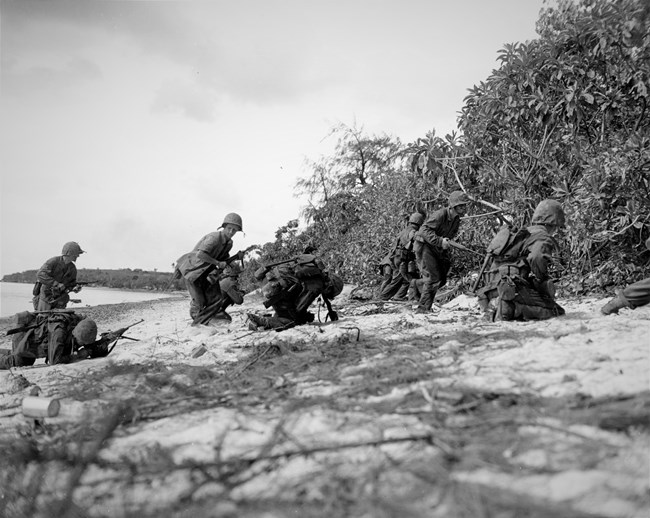
Photo Taken by a U.S. Coast Guard Photographer. Saipan, the second largest island in the Marianas, was a major Japanese base and sugar production area, complete with a fairly extensive road network and narrow-gauge rail system. There was a large Japanese civilian population, numbering about 20,000, in addition, there were about 4000 Chamorros on the island. By the time of the American invasion, Saipan had a garrison of about 32,000 men. It was about twice the size of American intelligence estimates. Facing fierce Japanese resistance, Americans poured from their landing crafts to establish a beachhead, battle Japanese soldiers inland and force the Japanese army to retreat north. Fighting became especially brutal and prolonged around Mount Tapotchau, Saipan’s highest peak, and Marines gave battle sites in the area names such as “Death Valley” and “Purple Heart Ridge.” When the U.S. finally trapped the Japanese in the northern part of the island, Japanese soldiers launched a massive but futile banzai charge. On July 9, the U.S. flag was raised in victory over Saipan. Of the 71,000 U.S. troops that landed, nearly 3,000 were killed and more than 10,000 wounded. Out of the entire Japanese garrison of 30,000 troops, only 921 prisoners were captured; the rest died. The Japanese commanders and some 5,000 others committed suicide rather than surrender. On 9-12 July, hundreds of Japanese civilians committed suicide, many by leaping off the high cliffs on the northern end of the island. Some of those who hesitated were shot down by holed-up Japanese troops. Estimates of Japanese civilian deaths have varied widely. By most estimates, there were 26,000 civilians on the island at the time of the invasion, and the Americans interned about 18,000, suggesting a figure of about 8,000 civilians killed in the fighting and in the mass suicide. The U.S. victory on Saipan would prove to be one of the most important strategic moments of the war in the Pacific War, as the Japanese archipelago was now within striking distance of United States' B-29 bombers. Sources: NPS, Naval Heritage Command Center |
Last updated: June 25, 2021
